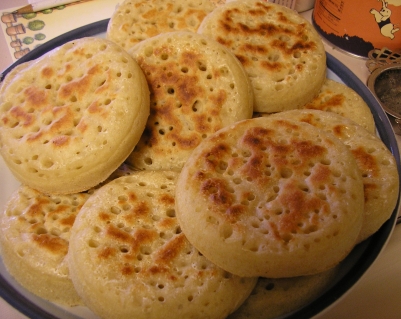I'm hesitant about trying to make my own crumpets, but I've now collected four tins to act as crumpet rings. These are from small bamboo shoot or water chestnut cans. People used to use tuna cans for this, but the powers that be rounded tuna can bottoms sometime in the recent past. You get rid of the lid and the bottom of can, hard to do if the can is curved at bottom edge.
Here's the recipe I'm using -
http://foppish-baker.blogspot.com/2005/12/crumpets.html, and this in turn is from The Bread Book by Linda Collister & Anthony Blake.
 Crumpets
Ingredients:
Crumpets
Ingredients: (makes about 18)
2 cups (230g) unbleached white bread flour
1 2/3 cups (230g) unbleached all purpose flour
¾ teaspoon cream of tartar
1 0.6oz cake fresh yeast (15g) or 1 envelope active dry yeast (2 ¼ teaspoons) plus ½ teaspoon sugar
2 ¼ cups (510ml) lukewarm water
3 ½ teaspoons (10g) coarse sea salt, crushed or ground (gk: use about half this if you're not grinding your own coarse sea salt -- or, y'know, if you're measuring by weight, not volume, you're fine.)
½ teaspoon baking soda
2/3 cup (140ml) lukewarm milk
a griddle or cast-iron frying pan
4 crumpet rings, about 3 ½ inches diameter, greased.
Instructions:
* Sift together the flours and cream of tartar into a large bowl. Crumble the fresh yeast into a medium-sized bowl. Mix in the lukewarm water until smooth. If using dry yeast, mix the granules and the sugar with ¾ cup lukewarm water and let stand until foamy, 5 to 10 minutes. Stir in the remaining lukewarm water.
* Mix the yeast mixture into the flour to make a very thick, but smooth batter, beating vigorously with your hand or a wooden spoon for two minutes. Cover the bowl with plastic wrap and let stand in a warm spot until the batter rises and then falls, about 1 hour.
* Add the salt and beat the batter for about 1 minute. Then cover the bowl and let stand in a warm spot for 15 to 20 minutes, so the batter can “rest”.
* Dissolve the baking soda in the lukewarm milk. Then gently stir it into t he batter. The batter should not be too stiff or your crumpets will be “blind” -- without holes – so it is best to test one before cooking the whole batch.
* Heat an ungreased (gk: oiled!), very clean griddle or frying pan over moderately low heat for about 3 minutes until very hot. Put a well-greased crumpet ring on the griddle. Spoon or pour 1/3 cup of the batter into the ring. The amount of batter will depend on the size of your crumpet ring.
* As soon as the batter is poured into the ring, it should begin to form holes. If holes do not form, add a little more lukewarm water, a tablespoon at a time, to the batter in the bowl and try again. If the batter is too thin and runs out under the ring, gently work in a little more all-purpose flour and try again. Once the batter is the proper consistency, continue with the remaining batter, cooking the crumpets in batches, three or four at a time. As soon as the top surface is set and covered with holes, 7 to 8 minutes, the crumpet is ready to flip over.
* To flip the crumpet, remove the ring with a towel or tongs, then turn the crumpet carefully with a spatula. The top, cooked side should be chestnut brown. Cook the second, holey side of the crumpet for 2 to 3 minutes, or until pale golden. The crumpet should be about ¾ inch thick. Remove the crumpet from the griddle. Grease the crumpet rings well after each use.
We'll see how I can manage to ruin them.
Anyone reading make their own crumpets or english muffins? Tell all...